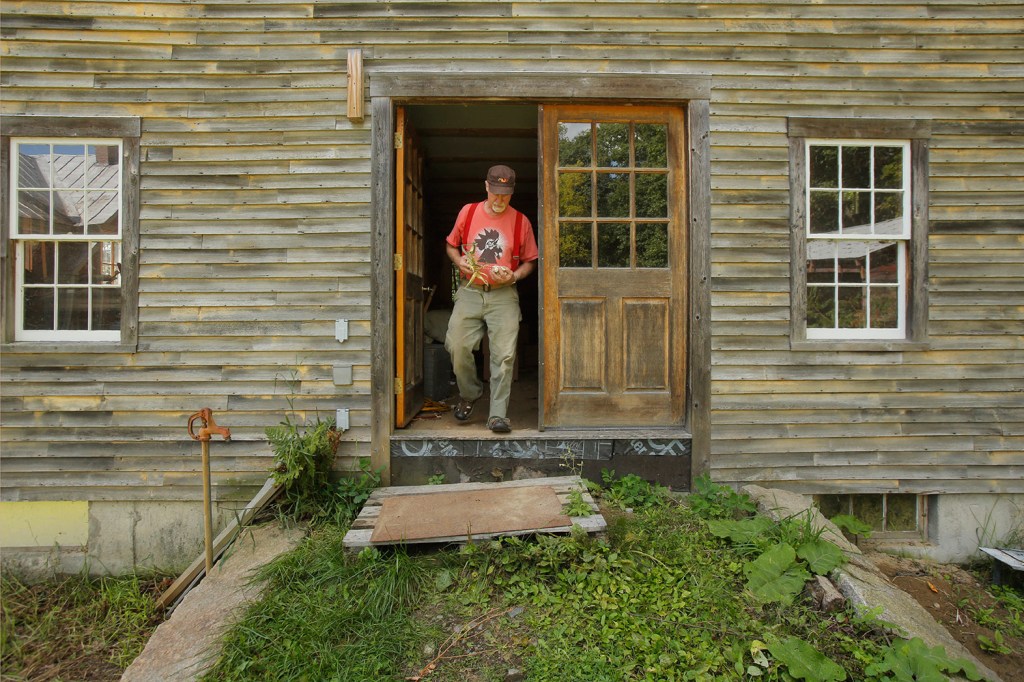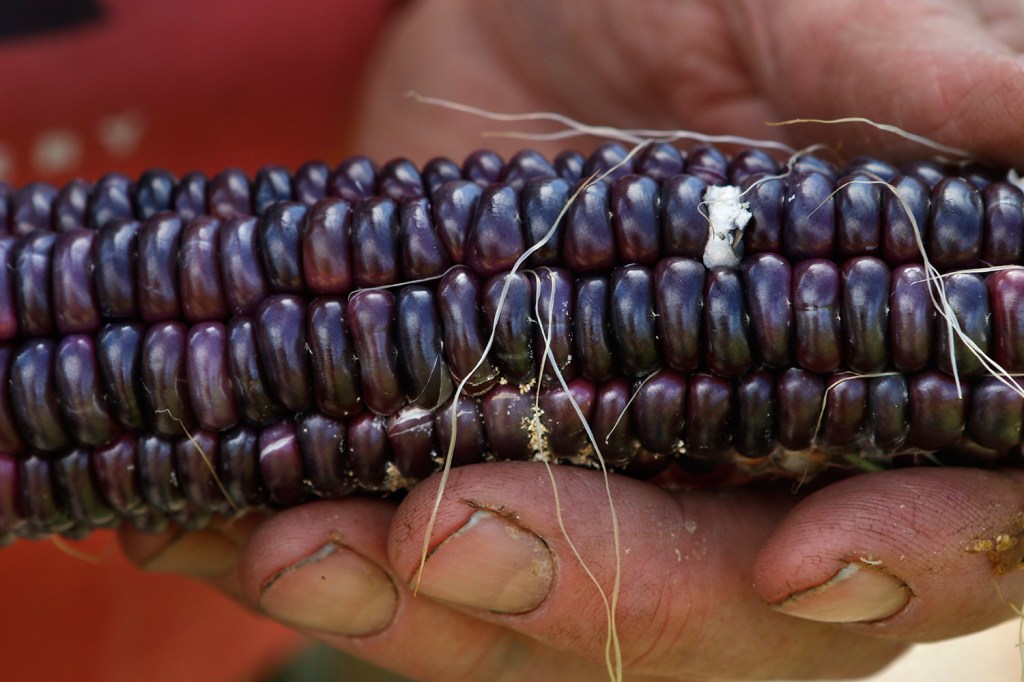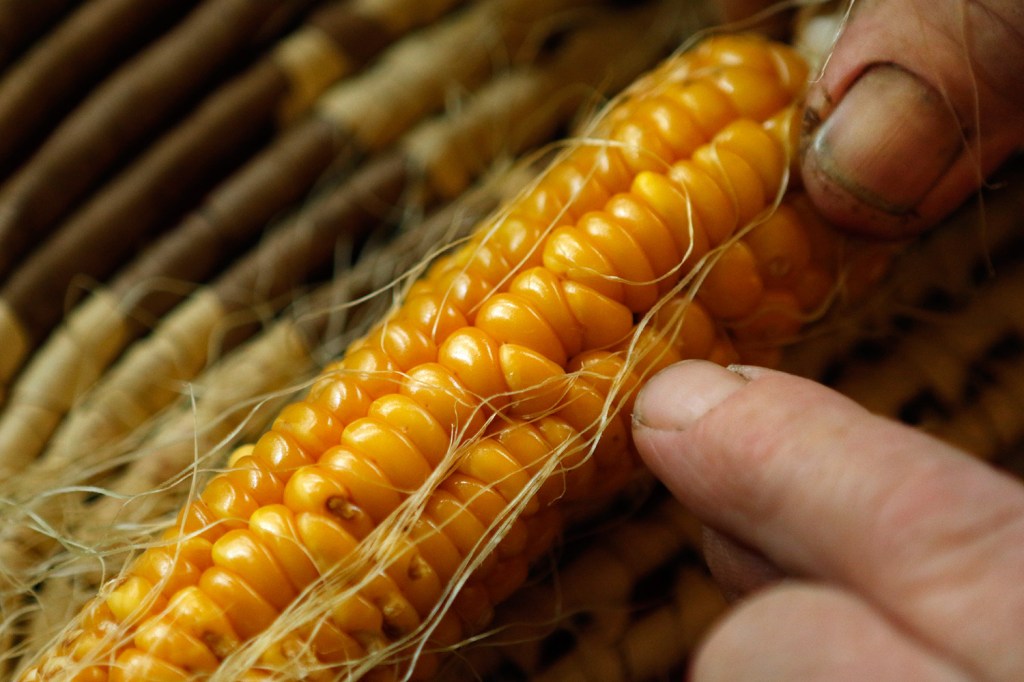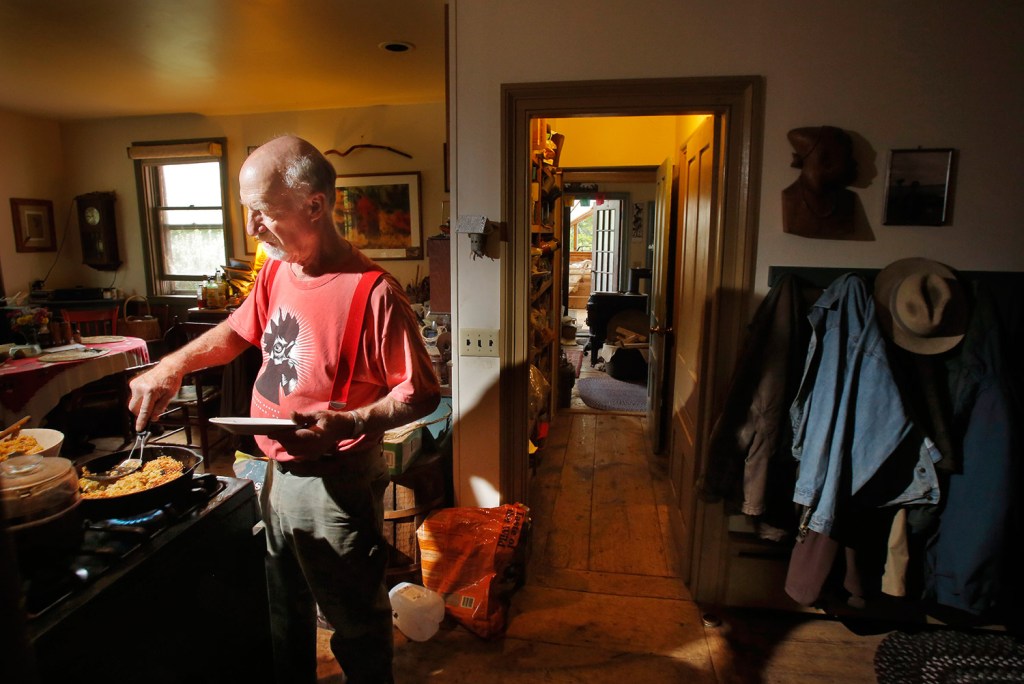NORRIDGEWOCK — Standing in a small cornfield just down the road from his house, Albie Barden tore the husk from an ear of corn with his rugged fingers, revealing rows of buttery gold corn kernels laced with threads of corn silk.
This flint corn, called Hubbard, was grown from seeds obtained from a federal seed vault, and the shucking marks the first time anyone has laid eyes on this variety in Maine in … no one really knows how long. There’s a little insect damage, and the ears are small, but the color is strikingly beautiful.
“This is the entire crop of Hubbard in this bag,” Barden said, showing a bag filled with about 30 ears of “ratty and unimpressive” corn cobs. “But when you save something from extinction by taking it out of a federal government vault, you don’t necessarily have something that’s going to be as good as it can get once people start playing with it and growing it out and feeding it properly.”
Albie Barden is perhaps best known to Mainers as the co-founder of both the Common Ground Fair and the Maine Wood Heat Co. in Skowhegan, which sells wood-fired ovens and masonry heaters all over the country. He is an organic gardener, former Episcopal priest and a co-founder of the Kneading Conference, an annual gathering of bakers trying to bring locally grown, heritage grains back into the mainstream. He is also a longtime “corn keeper” – a person who grows rare native corn varieties to help keep them from becoming extinct.
Barden is working with four Maine varieties of flint corn that were once grown by Native Americans – Hubbard, Fort Kent, Byron and Knowlton – as well as a half dozen or so other flint corn varieties. Flint corn, or “Indian corn,” has colorful kernels with a hard outer shell. It’s typically used for decoration (think corn husk wreaths) or ground into cornmeal. It produces fewer ears than modern field corn varieties (which are used for cornmeal and animal feed), making it less commercially viable.
For the past 30 years, Barden has been researching flint corn varieties, connecting with other corn keepers, and handing out thousands of rare kernels for farmers and gardeners to grow. To him, it is far more than just a hobby that has taken over his garden and fields.
“For me, it’s not about the crops,” he said. “It’s really about re-establishing a sacred relationship to the land and the plants, and honoring them as sacred beings with a history that have fed us forever.”
Barden not only wants to preserve the distinctive taste of these long-forgotten grains – he hopes they will re-appear on restaurant menus someday – he views saving them as a way to honor Native American cultural heritage, “healing the land and healing the tragic history” of Indian tribes in Maine.
He believes that if we can make some of these heirloom varieties as sacred to ourselves as they were to indigenous peoples, rather than just being a commodity or historical oddity, “we can get back on a healing path of right livelihood with the Earth.”
Amber Lambke, who co-founded the Kneading Conference with Barden and is CEO of Maine Grains, says the work that Barden has been quietly doing to put native varieties of flint corn seeds into the hands of willing growers is “vital and important.”
“He is simultaneously building the supply of endangered varieties while knitting back together a community of growers that share seed and keep beautiful, flavorful varieties alive in our foodways,” she said. “Albie is deeply connected to his land and the spiritual significance of growing food.”
MISSIONARY ZEAL
Barden lives in an old cape home with two barns, on a road that was once the old Indian trail that ran alongside the Kennebec River. The road is named after Father Sebastian Rasle, a Jesuit missionary who moved there in the late 17th century and lived among the Norridgewock tribe of the Abenaki Indians. The English and French fought over the natives’ land, and Rasle was murdered in an English raid that wiped out the Indian settlement in 1724. A monument to Rasle stands just a mile down the road from Barden’s home, on the site of the massacre.
Barden has lived on his 40-acre homestead for 45 years, and the historic and spiritual significance of the land has seeped into his 71-year-old bones. He looks at the large stones on the Kennebec riverbank and his mind drifts back 300 years, imagining native women grinding corn and singing, their children playing nearby.
He once canoed down the river with his own children, from their back yard to the sea, because he wanted them to experience the annual summer migration that the native people of Norridgewock took after planting their crops. You might think that given his intense interest in Native American history and culture, Barden is part Indian himself, but he is not. The first Barden to set foot on American soil landed in Plymouth, Mass., in 1636 as an indentured servant. Seven years later, that ancestor had his freedom and a trade – masonry, oddly enough, given what Barden does for a living in the 21st century.
Barden grew up in Stillwater, near Orono, in a family of biologists. His father gave him and his two siblings each their own row of sweet corn to grow and sell on the roadside. When relatives visited from Rhode Island, they always brought a 5-pound box of Kenyon’s Grist Mill‘s stone-ground Narragansett white flint corn – a variety that was once important to the Narragansetts and the Pequots. Barden’s family used it to make jonny cakes in a cast iron skillet, always eaten with butter and maple syrup. (Barden insists on spelling jonny cakes without an ‘h’ because, he says, the name stems from “journey cakes,” as the pancakes were easy to carry.)
More than 40 years ago, Barden was working as a priest – a priest who read the Whole Earth Catalog and the CoEvolution Quarterly – when he was “called” to his work with masonry heaters.
“I kept looking for meaning, for a God in the sky, and I could not find any,” he said. But as he immersed himself in the masonry work, “I was taken to a much deeper level of understanding of rocks and fire and wood.” He says he was given many signs that the plants, rocks and animals of the Earth are manifestations of the divine, lauching him on a spiritual journey he is still on.
Some 30 years ago, Barden’s interest in flint corn – sacred to Native Americans – took deeper root, when he met Will Bonsall, director of the Scatterseed Project in Industry. Bonsall had a flint corn variety called Byron that had been salvaged out of a shoebox in the little Oxford County town of Byron, population 145.
“It apparently had been widely grown along the Swift River in Byron as a meal corn,” Barden said. “He gave me some, and I grew it out in the high field,” protected by sturdy, electrified fences. “And the day it became ripe, the horses burst through both fences and ate every stalk to the ground. That was a depressing experience for me, and it kind of put my flint corn fanaticism on hold.”
Barden’s interest was reignited about 15 years ago, when he took a class in “plant spirit medicine” from Gail Edwards at Blessed Maine Herb Farm in Athens. He learned how to “connect” with plants and “the plant spirits” and use them as healing agents. He so took to the topic that eventually he was teaching a “mini-class” for Edwards, complete with shamanic drumming and “dream vision journeys.” One day a man in his 40s showed up at one of his classes.
“He was keeping a sacred fire, which means he was holding a fire and keeping it going day and night through the entire class,” Barden said. “He was sitting 20-30 feet away with his long black hair and a smile on his face, and he had this magnificent ear of corn in his hand.”
Barden asked him about it. The man, who was part Mic Mac, told him the corn was called Abenaki Rose, and that the variety had originated in Maine. His family had recently salvaged some from New York and brought it back home to grow. He gave Barden 12 kernels. Barden took them home, planted them, and all 12 came up. “That was magical in and of itself for me,” he said.
Barden nursed the plants with water and seaweed amendments. By the end of the growing season, he had 23 ears. “From those 23 ears,” he said, “I started to do a fairly significant giveaway of Abenaki Rose, with the idea that it was kind of a calling to preserve the ancient varieties of flint corn and to make sure that they survived.”
Barden says he’s given away “thousands and thousands and thousands” of Abenaki Rose seeds. Now that the seeds are available through Groundswell Seed Farm in Embden, Barden no longer plants it himself every year. But he keeps a photo of the gorgeous ears – each cream-colored kernel blotched with a large drop of crimson red – in his kitchen. “The energy of it is really extraordinary,” Barden said.
KEEPING THE FAITH
With the success of the Abenaki Rose project, Barden’s goal shifted to rediscovering all of the original Maine flint corns. He obtained more Byron seed from another corn keeper to grow and give away, and next year he plans to grow a Maine variety called Knowlton.
Tristan Noyes, executive director of the Maine Grain Alliance, said he felt “honored” when Barden asked him to become a corn keeper. “Albie knew exactly which flint corn would resonate most with me,” Noyes said, “a corn from my native Aroostook, a rare Fort Kent Golden Flint Corn.”
Barden is also working with other rare varieties that have interesting stories.
“I started reading years ago about a corn that (Samuel de) Champlain saw when he entered the St. Lawrence in the 1500s,” Barden said. “He looked over the railing of his boat, and there was this short corn growing, being tended by native people. They would have probably been the Mic Macs. That corn has come to be known historically as Gaspe flint. So I began to search for it.”
Barden eventually tracked down a farmer in Indiana who had some. This year, Barden grew it in his kitchen garden, but the birds got to it before he could harvest it. He also grew a variety from New York called Gigi Hill, a shorter season blue flint corn.
“I thought it was going to be a blue corn, and I was stunned because it turned out to be cream colored,” Barden said as he pulled an ear from a stalk in the field. “So I hung it from my pot rack over the sink. Day after day as it dried, it started turning blue.”
A stunning, deep blue.
SAY A LITTLE PRAYER
Barden’s interest in Native American culture is reflected throughout his homestead. He shows off a huge pestle he found in a barn in Belgrade that would have been used to grind corn in a hollowed-out stump, making a deep thumping sound like an American bittern in a marsh. He also brings out his antique corn scraper, pointing out that Maine tribes would have used the jawbone of a deer.
Barden has collected a half-dozen or so antique corn shellers, including a fully restored one that was made in Winthrop in the early 19th century. It looks something like a beehive. He pulled it out into the yard to demonstrate how the gears strip the kernels from the cob.
Thriving in a corner of the garden is a patch of tobacco, grown from seeds that a Passamaquoddy elder gave to Barden. They came, the story goes, from 1,200-year-old seeds discovered in an Indian grave in Ontario. Barden uses the tobacco to enhance his year-round evening routine in which he “acknowledges” all of the plants and animals on his property by name in a prayer, and then sprinkles dried, crushed tobacco as an offering.
Barden thinks it’s no accident that the biblical Jesus had his last encounter with God on Earth in a garden. Here in Barden’s world, it’s not too hard to imagine the divine speaking to a humble corn keeper.
Send questions/comments to the editors.









Success. Please wait for the page to reload. If the page does not reload within 5 seconds, please refresh the page.
Enter your email and password to access comments.
Hi, to comment on stories you must . This profile is in addition to your subscription and website login.
Already have a commenting profile? .
Invalid username/password.
Please check your email to confirm and complete your registration.
Only subscribers are eligible to post comments. Please subscribe or login first for digital access. Here’s why.
Use the form below to reset your password. When you've submitted your account email, we will send an email with a reset code.